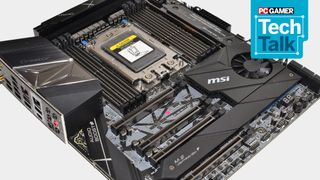Why I love extreme motherboards
There's nothing quite like HEDT motherboards, even if they're totally impractical.

Last month, AMD and Intel launched new high-end desktop (HEDT) processors, providing us a taste of the future. The chips are extremely fast in the right workloads—they're not the best CPUs for gaming, but the Threadripper 3970X is over three times as fast as Intel's Core i9-9900KS in 3D rendering, for example. But what I really love about HEDT builds is the attention to detail and the "everything plus the kitchen sink" approach to motherboards. Forget about price for a moment, these boards are simply beautiful.
The Asus ROG Zenith II Extreme for the TRX40 platform has mirrored surfaces, plenty of RGB lighting, an OLED display above the rear IO block, and ports. So many ports! Does anyone actually use all of the features on one of these HEDT boards? Probably not, but they're there just in case. 4-way RAID 0 M.2 SSDs and more than 10GB/s of combined transfer speeds—why not?
But it doesn't end there. The TRX40 platform supports up to 72 PCIe Gen4 lanes, twice the bandwidth per lane of PCIe Gen3. There are eight SATA ports, and up to 21 USB ports of various types (12 provided on the back I/O panel). Then there's the metal backplate, multiple RGB headers, 10G Ethernet and Wi-Fi 6 (up to 1.73Gbps speed) networking, DTS audio, and more. Not surprisingly, there's even an LN2 mode (for liquid nitrogen cooling), because boards like this are meant to break every possible performance record.
What's impressive is that even with all those features, Asus still manages to make a board that looks sexy. Or at least, it looks sexy to this unabashed hardware nerd. Oh, and it has a recommended price of $850.




Asus isn't alone. Gigabyte has the TRX40 Aorus Xtreme, also priced at $849. MSI's Creator TRX40 tips the scales at just $700, with support for up to seven M.2 drives via the included expansion card—it has a heatsink and fan and four M.2 slots. ASRock's TRX40 Taichi is almost tame by comparison, priced to move at only $499.
There are far less expensive motherboards, though. You can put together a decent gaming PC with a Ryzen 5 3600 or Core i5-9400F for less than the price of some of these motherboards. But the point isn't whether you should be buying this extreme kit. The goal instead is to showcase the pinnacle of current PC engineering—it's what happens when you unleash the hounds and ask for the best possible hardware, cost and practicality be damned, and I love it for that.
Such feats of engineering are wasted on mere mortal PCs, but when overclockers start breaking out the liquid nitrogen—or maybe even liquid helium—run of the mill motherboards simply won't suffice. These are the Formula One engines and racecars of the PC realm. They're not meant for daily commuters and don't even belong on the city streets, but they're great for bragging rights among the hardware companies. And over the next five to ten years, some of the tech that went into creating these beauties will trickle down into our regular gaming rigs.
The biggest gaming news, reviews and hardware deals
Keep up to date with the most important stories and the best deals, as picked by the PC Gamer team.
This is the sort of hardware we use in Maximum PC's Dream Machine. Powerful and fast, but also easy on the eyes. The list of candidates for DM 2020 has arrived.
Jarred's love of computers dates back to the dark ages when his dad brought home a DOS 2.3 PC and he left his C-64 behind. He eventually built his first custom PC in 1990 with a 286 12MHz, only to discover it was already woefully outdated when Wing Commander was released a few months later. He holds a BS in Computer Science from Brigham Young University and has been working as a tech journalist since 2004, writing for AnandTech, Maximum PC, and PC Gamer. From the first S3 Virge '3D decelerators' to today's GPUs, Jarred keeps up with all the latest graphics trends and is the one to ask about game performance.
Most Popular


